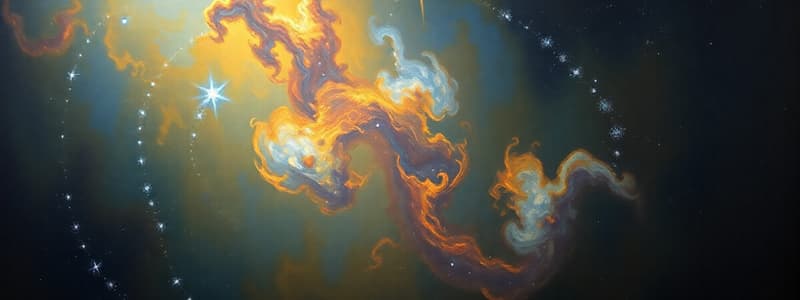Podcast
Questions and Answers
Given the astrophysical dynamics of T Coronae Borealis (T CrB), what primary mechanism precipitates the recurring nova outbursts, considering the interplay between the red giant and white dwarf components?
Given the astrophysical dynamics of T Coronae Borealis (T CrB), what primary mechanism precipitates the recurring nova outbursts, considering the interplay between the red giant and white dwarf components?
- Magnetohydrodynamic instabilities within the accretion disk surrounding the white dwarf, leading to episodic accretion events and subsequent thermonuclear detonations, mediated by the magnetic field strength.
- Gravitational tidal forces exerted by the red giant on the white dwarf, inducing recurrent seismic events culminating in a nova-scale eruption, influenced by the Roche lobe geometry.
- Neutrino cooling processes within the white dwarf's core, triggering a sudden collapse and rebound resulting in a nova outburst, coupled with the periodic mass transfer from the red giant.
- Thermal runaway initiated by hydrogen fusion on the white dwarf's surface, fueled by accreted material from the red giant, modulated by the CNO cycle and degeneracy pressure within the dwarf's core. (correct)
T Coronae Borealis system exhibits recurring nova events. Considering stellar evolution models, what is the most likely long-term fate of the white dwarf within this binary system, assuming continued accretion and thermonuclear ignition?
T Coronae Borealis system exhibits recurring nova events. Considering stellar evolution models, what is the most likely long-term fate of the white dwarf within this binary system, assuming continued accretion and thermonuclear ignition?
- The white dwarf will evolve into a neutron star via accretion-induced collapse, triggered by electron capture processes in its core.
- The white dwarf will stabilize as a helium-burning star, achieving equilibrium between gravitational forces and nuclear energy generation.
- The white dwarf will eventually undergo a Type Ia supernova explosion once it exceeds the Chandrasekhar limit due to continued accretion. (correct)
- The white dwarf will gradually cool and dim, transitioning into a black dwarf after exhausting its nuclear fuel without reaching the Chandrasekhar limit.
What observational signatures, beyond the visual spectrum, would provide the most compelling evidence to differentiate a classical nova outburst like that of T Coronae Borealis from other transient astronomical phenomena, such as superluminous supernovae or tidal disruption events?
What observational signatures, beyond the visual spectrum, would provide the most compelling evidence to differentiate a classical nova outburst like that of T Coronae Borealis from other transient astronomical phenomena, such as superluminous supernovae or tidal disruption events?
- Detection of highly redshifted iron emission lines in the X-ray spectrum, indicative of relativistic outflow velocities characteristic of tidal disruption events.
- Presence of strong, broad Balmer lines with P Cygni profiles in the optical spectrum, coupled with enhanced gamma-ray emission from radioactive decay products formed during nucleosynthesis. (correct)
- Identification of quasi-periodic oscillations in the ultraviolet light curve, associated with accretion disk instabilities in a black hole binary system.
- Observation of coherent radio pulsations indicative of a newly formed magnetar resulting from a supernova explosion.
Considering the orbital parameters and mass transfer rate within the T Coronae Borealis system, what stellar atmospheric processes most critically influence the chemical composition of the material accreted onto the white dwarf's surface?
Considering the orbital parameters and mass transfer rate within the T Coronae Borealis system, what stellar atmospheric processes most critically influence the chemical composition of the material accreted onto the white dwarf's surface?
In the context of predicting the precise timing of the next nova outburst from T Coronae Borealis, what advanced statistical methodologies could be employed to refine current estimations, given the historical light curve data and known system parameters?
In the context of predicting the precise timing of the next nova outburst from T Coronae Borealis, what advanced statistical methodologies could be employed to refine current estimations, given the historical light curve data and known system parameters?
Assuming advanced interstellar travel capabilities, what in-situ measurements within the T Coronae Borealis system would provide the most critical constraints on the physical processes governing the nova cycle, and what instruments would be required to obtain these measurements?
Assuming advanced interstellar travel capabilities, what in-situ measurements within the T Coronae Borealis system would provide the most critical constraints on the physical processes governing the nova cycle, and what instruments would be required to obtain these measurements?
Considering the potential impact of a nova outburst on nearby exoplanetary systems (assuming hypothetical planets orbiting T Coronae Borealis), what radiative transfer mechanisms would govern the propagation of energy and momentum through the circumstellar environment, and what would be the most significant consequences for planetary atmospheres?
Considering the potential impact of a nova outburst on nearby exoplanetary systems (assuming hypothetical planets orbiting T Coronae Borealis), what radiative transfer mechanisms would govern the propagation of energy and momentum through the circumstellar environment, and what would be the most significant consequences for planetary atmospheres?
Assuming the detection of a similar recurrent nova system in another galaxy, what multi-wavelength observational strategies would be most effective in determining its distance, given the uncertainties associated with standard candle calibrations?
Assuming the detection of a similar recurrent nova system in another galaxy, what multi-wavelength observational strategies would be most effective in determining its distance, given the uncertainties associated with standard candle calibrations?
Flashcards
Nova
Nova
A celestial event where a binary star system, consisting of a red giant and a white dwarf, produces a burst of energy, dramatically increasing in brightness.
Binary Star System
Binary Star System
A binary star system consisting of a red giant and a white dwarf star.
Red Giant
Red Giant
A large, aging star that is shedding its outer layers.
White Dwarf
White Dwarf
Signup and view all the flashcards
Nova Explosion Date
Nova Explosion Date
Signup and view all the flashcards
T Coronae Borealis (T CrB)
T Coronae Borealis (T CrB)
Signup and view all the flashcards
Material Accumulation
Material Accumulation
Signup and view all the flashcards
T CrB Nova Outburst Frequency
T CrB Nova Outburst Frequency
Signup and view all the flashcards
Study Notes
- A rare nova outburst is predicted by NASA to occur between now and September.
- The nova can be observed from anywhere on Earth without special equipment.
What is a Nova?
- A nova occurs in binary star systems with a red giant and white dwarf.
- Material shed by the red giant accumulates on the white dwarf's surface.
- Eventually, the gathered material explodes, creating a nova.
- Novas result in a sudden increase in brightness, illuminating the night skies.
- The upcoming T Coronae Borealis nova eruption will be visible without a telescope.
What is T Coronae Borealis?
- T Coronae Borealis (T CrB) is a binary star system 3,000 light-years from Earth.
- It is known for periodic nova outbursts, occurring about every 80 years.
- The last T CrB outburst was in 1946.
- Outbursts are caused by the red giant shedding its outer layers onto the white dwarf.
- This heats the white dwarf's atmosphere, leading to an eruption.
- T CrB's white dwarf survives each nova and experiences it again in the future.
- As matter accumulates, pressure increases until there is "a runaway reaction".
When Will The Explosion Occur?
- NASA expects the nova explosion before September 2024.
- The exact timing is difficult to determine.
- It may occur in the next couple of months, very probably before the end of summer.
- The nova outburst will be visible to the naked eye for several days.
- With binoculars, the nova will be visible for just over a week.
- It will appear as a bright star in the northern sky.
Studying That Suits You
Use AI to generate personalized quizzes and flashcards to suit your learning preferences.




